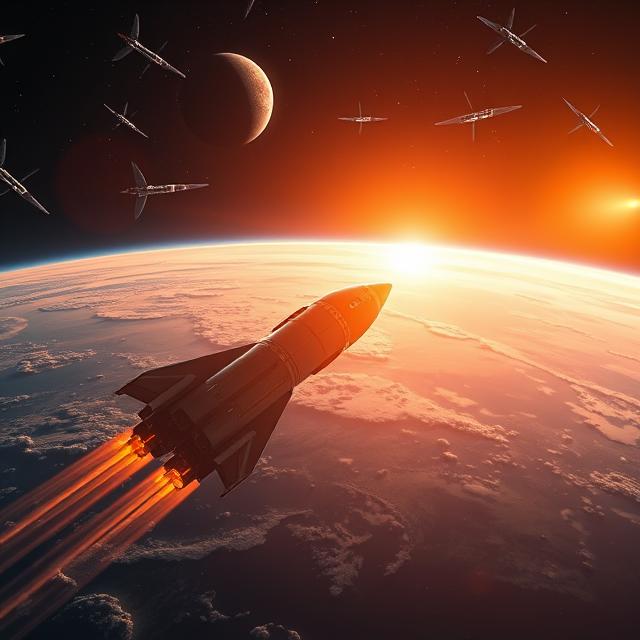Space tourism and commercial spaceflights represent one of the most exciting frontiers in human exploration. Once the domain of government-funded space agencies like NASA and Roscosmos, the launch of commercial space companies like SpaceX, Blue Origin, and Virgin Galactic is transforming space travel into an emerging industry with the potential to reshape how humans experience space. This article explores the current state of space tourism, its future prospects, and the technological, economic, and ethical implications of venturing into space for leisure and business.
1. Introduction: The Dawn of Space Tourism
Space tourism refers to the commercial activity of sending private individuals into space for leisure, research, or experience rather than scientific or military purposes. While space travel has been reserved for astronauts and professionals in the past, the rise of private spaceflight companies has led to the possibility of ordinary people becoming space tourists.
The concept of space tourism is not entirely new. It has been the subject of science fiction for decades, with authors and filmmakers imagining a time when space would be as accessible as air travel. However, in recent years, private companies have moved toward turning this dream into reality, achieving milestones that were once thought to be beyond reach.
2. The Current State of Space Tourism
2.1 Key Players in the Space Tourism Industry
Several private companies are currently leading the space tourism movement, each with its own vision of how space travel should be conducted:
- Virgin Galactic: Founded by Richard Branson, Virgin Galactic focuses on suborbital flights that take passengers just beyond the Kármán Line (the edge of space). The company’s SpaceShipTwo is designed to carry tourists to space for a few minutes of weightlessness and a view of Earth from above.
- Blue Origin: Founded by Amazon’s Jeff Bezos, Blue Origin has developed the New Shepard rocket, which can carry both astronauts and paying customers on suborbital flights. Blue Origin’s approach emphasizes safety and comfort, with a capsule that allows passengers to experience weightlessness and view the curvature of the Earth.
- SpaceX: Founded by Elon Musk, SpaceX has a more ambitious vision for space tourism, with its Crew Dragon spacecraft and Starship rockets being designed for orbital and interplanetary travel. SpaceX has already achieved major milestones in space exploration, including sending private astronauts to the International Space Station (ISS).
- Axiom Space: Focused on offering trips to the International Space Station, Axiom Space aims to give private individuals a chance to live and work in space for extended periods.
2.2 Types of Space Tourism
Space tourism can be categorized into three main types, each offering a unique experience:
Suborbital Space Tourism
Suborbital flights are the most common form of space tourism currently being offered. These flights take passengers to the edge of space, just past the Kármán Line (approximately 100 kilometers above Earth), where they experience a few minutes of weightlessness. However, suborbital flights do not complete an orbit around Earth, meaning the journey is brief. Companies like Virgin Galactic and Blue Origin are focused on making suborbital space tourism accessible to the public.
Orbital Space Tourism
Orbital space tourism involves sending passengers into Earth’s orbit, where they can spend extended periods of time aboard space stations or even orbit the Earth multiple times. SpaceX’s Crew Dragon is already capable of orbital tourism, as evidenced by missions like Inspiration4, the first all-civilian mission to orbit Earth in 2021. In the future, orbital space tourism could include stays at private space stations or even lunar missions.
Lunar and Deep Space Tourism
Though still in the early stages, the concept of lunar and deep space tourism is beginning to take shape. SpaceX has announced plans to send private tourists around the Moon aboard its Starship vehicle, and other companies are exploring the potential for future space voyages that extend beyond Earth’s orbit. Deep space tourism could include missions to Mars or other destinations in the solar system, with an emphasis on the long-term settlement of space.
3. The Technology Behind Commercial Spaceflights
The development of commercial spaceflights is heavily reliant on cutting-edge technologies that push the boundaries of space exploration. These innovations are revolutionizing how we think about human space travel.
3.1 Rockets and Spacecraft
To transport civilians into space, private companies need reliable, reusable rockets and spacecraft. Some of the most significant advancements include:
- Reusable Rockets: Companies like SpaceX and Blue Origin have pioneered the development of reusable rockets, which dramatically reduce the cost of space travel. For example, SpaceX’s Falcon 9 rocket is designed to return to Earth after launch, where it can be refurbished and used again.
- Spacecraft Design: Spacecraft such as SpaceX’s Crew Dragon and Blue Origin’s New Shepard are designed with safety and comfort in mind. Features like large windows for views of Earth and comfortable seating are essential for passenger satisfaction on suborbital and orbital missions.
3.2 Life Support Systems
Space tourism companies must also develop effective life support systems to keep passengers safe and comfortable during their flights. These systems include:
- Oxygen Supply: Ensuring passengers have enough oxygen to breathe during launch, orbit, and re-entry.
- Temperature Control: Spacecraft must maintain an ideal temperature for passengers, despite extreme conditions in space.
- Waste Management: In microgravity, efficient waste management systems are crucial for long-duration flights.
3.3 Spaceports and Infrastructure
To facilitate space tourism, spaceports (the equivalent of airports for space) are being developed around the world. These spaceports are designed to launch and land commercial spaceflights and provide the infrastructure necessary for future space tourism operations.
4. The Economic Impact of Space Tourism
4.1 Market Growth and Economic Potential
The space tourism industry is still in its early stages, but experts predict it will become a multi-billion-dollar market in the coming decades. According to some forecasts, space tourism could generate up to $3 billion annually by the 2030s.
The economic impact extends beyond the tourism sector, influencing related industries such as:
- Aerospace manufacturing
- Hospitality
- Transportation
- Media and entertainment
The growth of the commercial spaceflight industry will also create numerous high-paying jobs in engineering, science, and space operations, boosting local economies, especially around spaceport locations.
4.2 Expanding Space Exploration Horizons
Space tourism is not just about the luxury of traveling to space. It has the potential to drive forward human exploration of the solar system. The revenue generated from space tourism could be reinvested into research and development for more ambitious space missions, such as Moon landings, Mars exploration, and asteroid mining.
5. Challenges and Risks in Space Tourism
Despite the excitement surrounding space tourism, there are significant challenges and risks that must be addressed to ensure the safety and sustainability of the industry.
5.1 Safety Concerns
Space tourism involves inherent risks due to the extreme environment of space. To mitigate these risks, spaceflight companies must adhere to strict safety standards and undergo rigorous testing. Recent accidents, like the tragic crash of Virgin Galactic’s SpaceShipTwo in 2014, highlight the dangers of human spaceflight. Companies are investing heavily in flight safety technology and ensuring that crews and passengers are well-trained.
5.2 Environmental Impact
The environmental impact of space tourism is another major consideration. Rocket launches generate large amounts of carbon emissions and may contribute to atmospheric pollution. Companies are exploring environmentally friendly propulsion systems, such as electric propulsion and hydrogen-powered rockets, to reduce the environmental footprint of space tourism.
5.3 Cost of Space Tourism
While the price of a ticket to space has decreased over time, space tourism is still primarily accessible to the wealthy elite. Ticket prices for suborbital flights typically range from $250,000 to $500,000, with orbital missions costing millions of dollars. As technology advances and demand grows, the cost of space tourism is expected to decrease, but it will still be some time before it becomes accessible to the general public.
6. The Future of Space Tourism
6.1 The Democratization of Space Travel
In the future, space tourism will likely become more democratized. As space technologies evolve, costs will fall, and commercial flights may be within reach for a broader population. Initiatives like SpaceX’s Starship may pave the way for more affordable space travel, with the potential to make space tourism as common as air travel.
6.2 Long-Term Visions: Space Hotels and Lunar Colonies
Looking beyond space tourism, companies are envisioning long-term space hotels and even lunar colonies as possible destinations for tourists. The Axiom Space Station, for example, could serve as a hub for future space tourism, offering longer stays in orbit.
In the distant future, missions to the Moon and even Mars could provide an entirely new frontier for tourism and exploration.
Conclusion
Space tourism and commercial spaceflights are on the brink of revolutionizing human space exploration. While there are still significant technological, economic, and safety challenges to overcome, the efforts of companies like Virgin Galactic, Blue Origin, and SpaceX are laying the groundwork for a new era of space exploration. As we venture beyond Earth, space tourism has the potential to become an industry that not only inspires the next generation of explorers but also transforms how we think about the future of humanity in space.
Key Takeaways:
- Space tourism is an emerging industry aimed at making space travel accessible to private individuals.
- Virgin Galactic, Blue Origin, and SpaceX are key players in this new frontier of space exploration.
- Suborbital flights, orbital missions, and lunar tourism represent the primary categories of space tourism.
- Challenges include safety, environmental impact, and the high cost of tickets.
- The future of space tourism includes more affordable space travel, space hotels, and even lunar colonies.




